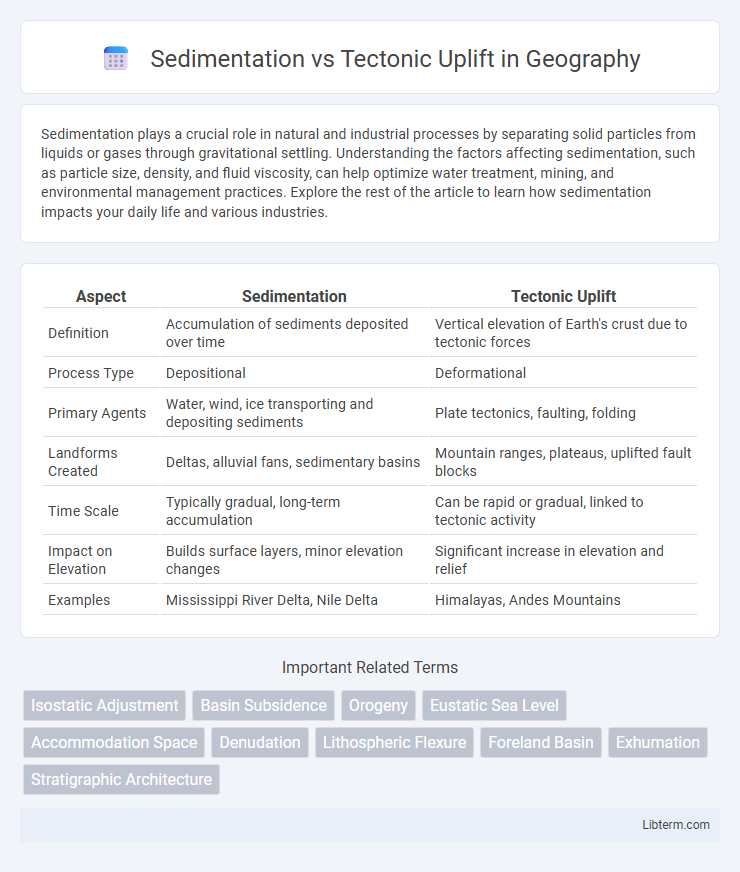Sedimentation plays a crucial role in natural and industrial processes by separating solid particles from liquids or gases through gravitational settling. Understanding the factors affecting sedimentation, such as particle size, density, and fluid viscosity, can help optimize water treatment, mining, and environmental management practices. Explore the rest of the article to learn how sedimentation impacts your daily life and various industries.
Table of Comparison
| Aspect | Sedimentation | Tectonic Uplift |
|---|---|---|
| Definition | Accumulation of sediments deposited over time | Vertical elevation of Earth's crust due to tectonic forces |
| Process Type | Depositional | Deformational |
| Primary Agents | Water, wind, ice transporting and depositing sediments | Plate tectonics, faulting, folding |
| Landforms Created | Deltas, alluvial fans, sedimentary basins | Mountain ranges, plateaus, uplifted fault blocks |
| Time Scale | Typically gradual, long-term accumulation | Can be rapid or gradual, linked to tectonic activity |
| Impact on Elevation | Builds surface layers, minor elevation changes | Significant increase in elevation and relief |
| Examples | Mississippi River Delta, Nile Delta | Himalayas, Andes Mountains |
Understanding Sedimentation: Key Processes and Impacts
Sedimentation involves the accumulation of mineral and organic particles transported by water, wind, or ice, forming layered deposits essential for soil fertility and habitat creation. Key processes include weathering, erosion, transportation, deposition, and compaction, each playing a crucial role in shaping sedimentary environments and influencing landscape evolution. Sedimentation impacts ecosystem dynamics, groundwater recharge, and carbon sequestration, while its interaction with tectonic uplift drives mountain building, basin formation, and changes in sediment supply and distribution.
What Is Tectonic Uplift? Geologic Forces at Work
Tectonic uplift refers to the vertical elevation of the Earth's surface caused by geologic forces such as plate tectonics, faulting, and volcanic activity. This process results in mountain building, crustal thickening, and the exposure of previously buried rock layers. Unlike sedimentation, which involves the accumulation of material, tectonic uplift actively reshapes the landscape through the upward movement of the Earth's crust.
Comparing Sedimentation and Tectonic Uplift: Definitions and Differences
Sedimentation is the geological process where particles settle and accumulate to form sedimentary layers, often in bodies of water, whereas tectonic uplift involves the vertical elevation of Earth's surface due to plate tectonic forces. Sedimentation primarily contributes to the buildup of sedimentary rock sequences, while tectonic uplift reshapes landscapes by raising landmasses and forming mountains. The key difference lies in sedimentation being a depositional process, whereas tectonic uplift is a structural deformation driven by tectonic plate movements.
The Role of Plate Tectonics in Landscape Transformation
Plate tectonics plays a crucial role in landscape transformation by driving tectonic uplift, which raises landmasses and creates mountain ranges, significantly altering erosion and sedimentation patterns. Sedimentation accumulates material eroded from uplifted terrains, forming basins and influencing sedimentary rock layers vital for understanding Earth's geological history. The dynamic interplay between tectonic uplift and sedimentation shapes topography, controls drainage systems, and impacts ecosystems over geological timescales.
How Sedimentation Shapes Earth’s Surface
Sedimentation plays a crucial role in shaping Earth's surface by depositing layers of sediment that build up landscapes such as deltas, floodplains, and continental shelves. Over time, these accumulated sediments lithify into sedimentary rock, influencing topography and creating basins that store fossil fuels and groundwater. Contrastingly, tectonic uplift elevates land, but sedimentation continuously modifies and reshapes these uplifted areas by erosion, transport, and deposition processes.
Interactions Between Sedimentation and Uplift Mechanisms
Sedimentation and tectonic uplift are interrelated processes where sediment accumulation influences crustal loading and subsidence, while tectonic uplift alters topography and sediment transport pathways. Uplift generates accommodation space by increasing elevation and creating basins that capture sediments, whereas sedimentation can counteract uplift by adding mass and promoting isostatic adjustment. These interactions regulate landscape evolution, basin development, and stratigraphic architecture in active orogenic and sedimentary environments.
Case Studies: Real-World Examples of Sedimentation vs. Uplift
The Bengal Delta in South Asia exemplifies sedimentation as one of the world's largest deltas formed by the massive sediment deposition from the Ganges-Brahmaputra River system. In contrast, the Himalayas demonstrate tectonic uplift due to the ongoing collision between the Indian and Eurasian plates, raising the mountain range significantly over millions of years. These case studies highlight the dynamic interplay between sedimentation lowering landscapes and tectonic uplift elevating them, shaping Earth's surface continuously.
Environmental Consequences of Sedimentation and Uplift
Sedimentation increases nutrient loads and alters aquatic ecosystems by smothering habitats and reducing water quality, often leading to decreased biodiversity and disrupted food chains. Tectonic uplift reshapes landscapes, triggers erosion, modifies drainage patterns, and can induce seismic activity impacting human settlements and natural habitats. Both processes significantly influence sediment distribution, habitat structure, and ecosystem resilience, affecting biodiversity and environmental stability.
Sedimentation and Uplift in Mountain Building Events
Sedimentation plays a crucial role in mountain building events by depositing layers of sediment that contribute to the overall mass and pressure on tectonic plates, influencing their movement. Tectonic uplift occurs when these plates collide or shift, forcing the Earth's crust upwards and forming mountain ranges. The interplay between sedimentation rates and tectonic uplift intensity determines the structural complexity and elevation of emerging mountain systems.
Future Implications for Landforms: Balancing Sedimentation and Uplift
Balancing sedimentation and tectonic uplift shapes the evolution of landscapes, as sediment accumulation can offset the elevation changes caused by uplift, maintaining stable landforms over time. Predicting future topography requires modeling sediment supply, transport dynamics, and rates of crustal deformation to anticipate shifts in river courses, floodplains, and mountain relief. Understanding this interplay is crucial for managing natural hazards, ecosystem resilience, and land-use planning in tectonically active regions.
Sedimentation Infographic

 libterm.com
libterm.com